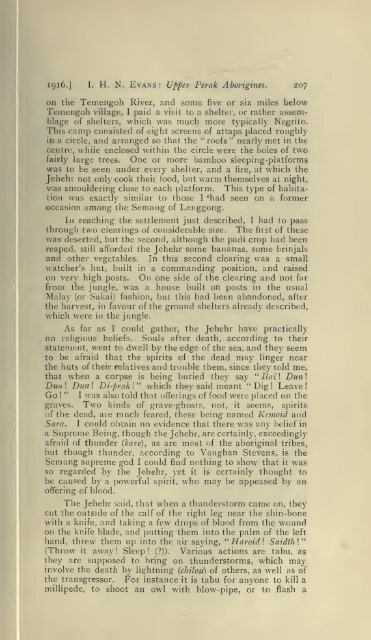Journal of the Federated Malay States museums - Sabrizain.org
Journal of the Federated Malay States museums - Sabrizain.org
Journal of the Federated Malay States museums - Sabrizain.org
You also want an ePaper? Increase the reach of your titles
YUMPU automatically turns print PDFs into web optimized ePapers that Google loves.
1916.] I. H. N. Evans: Upper Perak Aborigines. 207<br />
on <strong>the</strong> Temengoh River, and some five or six miles below<br />
Temengoh village, I paid a visit to a shelter, or ra<strong>the</strong>r assemblage<br />
<strong>of</strong> shelters, which was much more typically Negrito.<br />
This camp consisted <strong>of</strong> eight screens <strong>of</strong> attaps placed roughly<br />
in a circle, and arranged so that <strong>the</strong> "ro<strong>of</strong>s" nearly met in <strong>the</strong><br />
centre, a\ hile enclosed within <strong>the</strong> circle were <strong>the</strong> boles <strong>of</strong> two<br />
fairly large trees. One or more bamboo sleeping-platforms<br />
was to be seen under every shelter, and a fire, at which <strong>the</strong><br />
Jehehr not only cook <strong>the</strong>ir food, but warm <strong>the</strong>mselves at night,<br />
was smouldering close to each platform. This type <strong>of</strong> habitation<br />
was exactly similar to those I 'had seen on a former<br />
occasion among <strong>the</strong> Semang <strong>of</strong> Lenggong.<br />
In reaching <strong>the</strong> settlement just described, I had to pass<br />
through t\NO clearings <strong>of</strong> considerable size. The first <strong>of</strong> <strong>the</strong>se<br />
was deserted, but <strong>the</strong> second, although <strong>the</strong> padi crop had been<br />
reaped, still afforded <strong>the</strong> Jehehr some bananas, some brinjals<br />
and o<strong>the</strong>r vegetables. In this second clearing was a small<br />
watcher's hut, built in a commanding position, and raised<br />
on very high posts. On one side <strong>of</strong> <strong>the</strong> clearing and not far<br />
from <strong>the</strong> jungle, was a house built on posts in <strong>the</strong> usual<br />
<strong>Malay</strong> (or Sakai) fashion, but this had been abandoned, after<br />
<strong>the</strong> harvest, in favour <strong>of</strong> <strong>the</strong> ground shelters already described,<br />
which were in <strong>the</strong> jungle.<br />
As far as I could ga<strong>the</strong>r, <strong>the</strong> Jehehr have practically<br />
no religious beliefs. Souls after death, according to <strong>the</strong>ir<br />
statement, went to dwell by <strong>the</strong> edge <strong>of</strong> <strong>the</strong> sea, and <strong>the</strong>y seem<br />
to be afraid that <strong>the</strong> spirits <strong>of</strong> <strong>the</strong> dead may linger near<br />
<strong>the</strong> huts <strong>of</strong> <strong>the</strong>ir relatives and trouble <strong>the</strong>m, since <strong>the</strong>y told me,<br />
that when a corpse is being buried <strong>the</strong>y say "Bail Dun\<br />
Dunl Diinl Di-prak\" \\hich <strong>the</strong>y said meant "Dig! Leave!<br />
Go !<br />
" I was also told that <strong>of</strong>ferings <strong>of</strong> food were placed on <strong>the</strong><br />
graves. Two kinds <strong>of</strong> grave-ghosts, not, it seems, spirits<br />
<strong>of</strong> <strong>the</strong> dead, are much feared, <strong>the</strong>se being named Kemoid and<br />
Sara. I could obtain no evidence that <strong>the</strong>re was any belief in<br />
a Supreme Being, though <strong>the</strong> Jehehr, are certainly, exceedingly<br />
afraid <strong>of</strong> thunder {hare), as are most <strong>of</strong> <strong>the</strong> aboriginal tribes,<br />
but though thunder, according to Vaughan Stevens, is <strong>the</strong><br />
Semang supreme god I could find nothing to show that it was<br />
so regarded by <strong>the</strong> Jehehr, yet it is certainly thought to<br />
be caused by a powerful spirit, who may be appeased by an<br />
<strong>of</strong>fering <strong>of</strong> blood.<br />
The Jehehr said, that when a thunderstorm came on, <strong>the</strong>y<br />
cut <strong>the</strong> outside <strong>of</strong> <strong>the</strong> calf <strong>of</strong> <strong>the</strong> right leg near <strong>the</strong> shin-bone<br />
with a knife, and taking a few drops <strong>of</strong> blood from <strong>the</strong> wound<br />
on <strong>the</strong> knife blade, and putting <strong>the</strong>m into <strong>the</strong> palm <strong>of</strong> <strong>the</strong> left<br />
hand, threw <strong>the</strong>m up into <strong>the</strong> air saying, "Haroidl Saidthl"<br />
(Throw it away! Sleep! (?)). Various actions are tabu, as<br />
<strong>the</strong>y are supposed to bring on thunderstorms, which may<br />
involve <strong>the</strong> death by lightning (cJiilou) <strong>of</strong> o<strong>the</strong>rs, as well as <strong>of</strong><br />
<strong>the</strong> transgressor. For instance it is tabu for anj^one to kill a<br />
millipede, to shoot an owl with blow-pipe, or to flash a

















